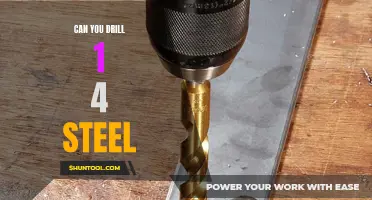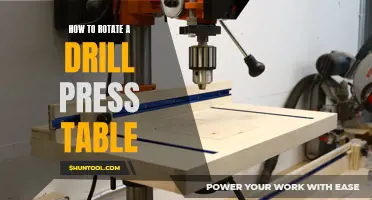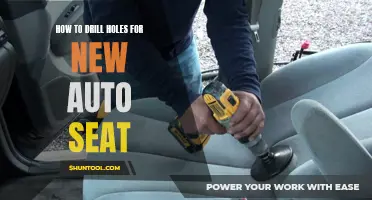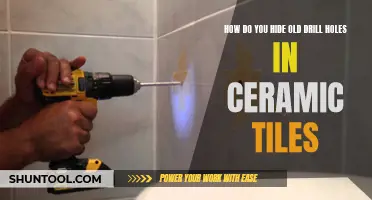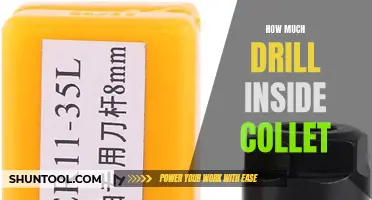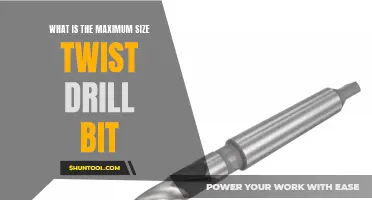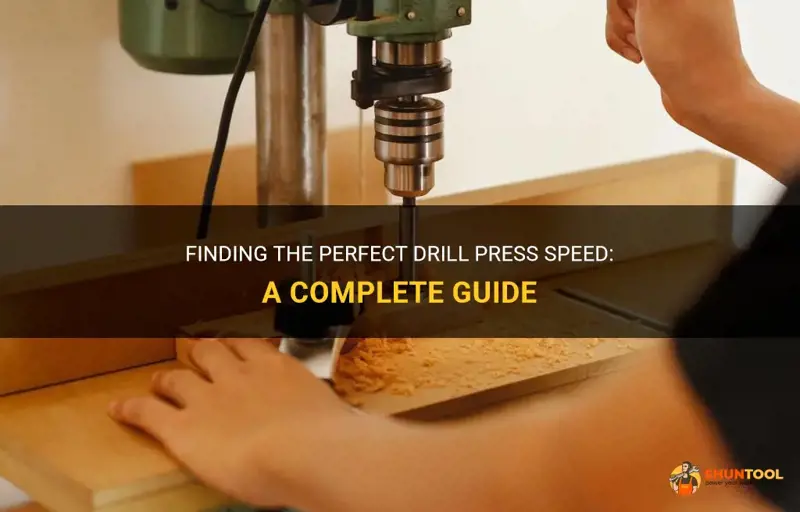
Drill presses are versatile tools that can be used to complete a wide range of tasks, from drilling through metal to creating precision holes in wood. However, in order to ensure successful and safe drilling, it is crucial to select the appropriate drill press speed. Determining the correct speed is a process that requires consideration of several factors, including the material being drilled, the size of the drill bit, and the desired outcome. By understanding these variables and following some simple guidelines, you can confidently select the perfect drill press speed for your specific project.
| Characteristics | Values |
|---|---|
| Material being drilled | Steel, Wood, Plastic, etc. |
| Drill bit diameter | 1/16", 1/4", 1/2", etc. |
| Material hardness | Soft, Hard, Medium, etc. |
| Cutting tool material | High-Speed Steel, Carbide, Cobalt, etc. |
| Feed rate | Slow, Medium, Fast |
| Desired hole quality | Smooth, Rough |
| Lubrication | Dry, Wet |
| Machine power | Low, Medium, High |
| Workpiece rigidity | Rigid, Flexible |
| Depth of cut | Shallow, Deep |
What You'll Learn
- What factors should be considered when determining the proper speed for a drill press?
- Does the type of material being drilled affect the recommended speed for a drill press?
- Are there any general guidelines or charts available to help determine the appropriate speed for different drill bit sizes and materials?
- What are the consequences of using the wrong speed on a drill press?
- How can the speed of a drill press be adjusted or set?

What factors should be considered when determining the proper speed for a drill press?
When using a drill press, it is important to determine the proper speed for the task at hand. The speed of a drill press is determined by the rotational speed of the spindle, which is measured in revolutions per minute (RPM).
There are several factors that should be considered when determining the proper speed for a drill press. These factors include the material being drilled, the size of the drill bit, and the type of hole being drilled.
The material being drilled is perhaps the most important factor to consider when determining the proper speed. Different materials require different drilling speeds in order to achieve the best results. For example, drilling through metal typically requires slower speeds, while drilling through wood can be done at higher speeds.
The size of the drill bit is also an important factor to consider. Larger drill bits require slower speeds, while smaller drill bits can be used at higher speeds. This is because larger drill bits have a greater circumference and therefore require more torque to rotate, which can lead to overheating if the speed is too high.
The type of hole being drilled is another factor to consider. Different types of holes require different speeds in order to achieve the desired result. For example, drilling a through hole typically requires a higher speed, while drilling a countersink hole may require a slower speed.
Experience and trial and error can also play a role in determining the proper speed for a drill press. By experimenting with different speeds and observing the results, one can determine the best speed for a given task. It is important to note that the proper speed may not always be the fastest speed. In some cases, a slower speed may be necessary in order to achieve a clean and precise hole.
In general, it is best to start at a slower speed and gradually increase the speed until the desired result is achieved. This allows for better control and reduces the risk of overheating or damaging the material being drilled. It is also important to make sure that the drill press is properly maintained and in good working condition, as this can affect the overall performance and speed of the machine.
In conclusion, determining the proper speed for a drill press involves considering factors such as the material being drilled, the size of the drill bit, and the type of hole being drilled. Experience and trial and error can also play a role in determining the best speed. By taking these factors into account, one can ensure that the drill press is operating at the optimal speed for the task at hand.
Choosing the Right Drill Bit for Resin: A Guide to Sizes and Types
You may want to see also

Does the type of material being drilled affect the recommended speed for a drill press?
When using a drill press, the type of material being drilled can indeed affect the recommended speed for drilling. Different materials have different properties and characteristics that can impact the drilling process. In this article, we will explore how the type of material affects the recommended speed for drilling on a drill press.
Firstly, it is important to understand that different materials have different hardness levels. Harder materials such as metals, hardwoods, and ceramics require higher drilling speeds, while softer materials like plastics and softwoods require lower drilling speeds. This is because harder materials require more force and heat to penetrate, and higher drilling speeds help to generate that force and heat.
Secondly, the type of drill bit being used also plays a role in determining the recommended drilling speed. Different drill bits are designed for specific materials and come with their own recommended speeds. For example, a drill bit designed for drilling into metal will have a higher recommended speed compared to a drill bit designed for drilling into wood. It is important to carefully read and follow the manufacturer's instructions regarding the recommended speed for each specific drill bit.
It is worth noting that drilling speeds are typically measured in revolutions per minute (RPM). Higher RPMs generally result in faster drilling, while lower RPMs provide more control and precision. Most drill presses have a variable speed control that allows you to adjust the RPM according to the material being drilled. It is recommended to start at a lower speed and gradually increase it until you find the optimal drilling speed for the specific material.
Furthermore, the size of the drill bit being used can also affect the recommended drilling speed. Larger drill bits require slower drilling speeds to prevent overheating and ensure clean cuts. Smaller drill bits, on the other hand, can handle higher drilling speeds. It is important to consider the size of the drill bit in relation to the material being drilled when determining the recommended speed.
In addition to the material, drill bit type, and size, the depth of the hole being drilled also affects the recommended speed. Deeper holes require slower drilling speeds to prevent overheating and ensure smooth drilling. Shallow holes may allow for higher drilling speeds as there is less surface area being drilled.
To illustrate the impact of material on drilling speeds, let's consider an example. Suppose you are drilling into a piece of hardwood using a standard twist drill bit. The recommended drilling speed for hardwood is generally around 2000-3000 RPM. However, if you were to drill into a sheet of plastic using the same bit, the recommended speed would be much lower, around 500-1000 RPM. These recommended speeds are based on the hardness and heat resistance of the materials.
In conclusion, the type of material being drilled does indeed affect the recommended speed for a drill press. Harder materials require higher drilling speeds, while softer materials require lower drilling speeds. It is important to consider factors such as drill bit type, size, and depth of the hole when determining the optimal drilling speed. By following the recommended speeds for each specific material, you can ensure efficient drilling and avoid potential problems such as overheating or poor quality cuts.
How to Successfully Remove a Stuck Case When Drilling Method Fails
You may want to see also

Are there any general guidelines or charts available to help determine the appropriate speed for different drill bit sizes and materials?
Determining the appropriate speed for drilling is crucial for achieving accurate and efficient results. Using the wrong speed can lead to overheating, dulling of the drill bit, or even damaging the workpiece. While there are general guidelines and charts available, it's important to take into account various factors such as the drill bit size and the material being drilled.
One commonly used guideline is the Surface Feet per Minute (SFM) method. SFM is a measurement of the speed at which the cutting edge of the drill bit moves across the surface of the material being drilled. To calculate SFM, you need to know the drill bit size and the rotational speed (RPM) of the drill. The formula for SFM is:
SFM = (RPM × drill bit diameter) / 3.82
For example, let's say you're using a 1/4 inch drill bit and the drill is rotating at 1000 RPM. The SFM would be:
SFM = (1000 × 1/4) / 3.82 = 65.97 SFM
Using this SFM value, you can refer to a chart that provides recommended SFM ranges for different materials. The chart typically includes values for various drill bit sizes and materials such as wood, metal, and plastic. By selecting the appropriate SFM range for your specific application, you can ensure optimal drilling speed.
Additionally, the type of material being drilled is also an important factor to consider. Different materials require different drilling speeds to achieve the best results. For example, wood can be drilled at higher speeds compared to metal, which requires slower speeds to avoid overheating and dulling the drill bit.
Here are some general guidelines for drilling different materials:
- Wood: For drilling wood, higher drilling speeds can be used. Typically, a range of 2000-3000 RPM is suitable for most wood drilling applications.
- Metal: Drilling metal requires slower speeds to prevent overheating and prolong the life of the drill bit. A range of 500-2000 RPM is commonly recommended for metal drilling.
- Plastic: When drilling plastic, it's important to use lower speeds to prevent melting or chipping. A range of 500-3000 RPM is suitable for plastic drilling.
It's essential to note that these are general guidelines, and the specific requirements may vary depending on the type and thickness of the material. It's always recommended to refer to the manufacturer's guidelines or consult experts for specific applications.
In conclusion, determining the appropriate drilling speed involves considering factors such as drill bit size and the material being drilled. The SFM method, along with charts providing recommended SFM ranges for different materials, can be a useful starting point. However, it's important to adjust the speed based on the specific requirements of the application and the material being drilled to achieve optimal results.
The Intensity of Pain When Drilling into Bone: What You Should Know
You may want to see also

What are the consequences of using the wrong speed on a drill press?
Using the drill press is a common task in many workshops and DIY projects. It provides precision drilling and is a versatile tool for various applications. However, using the wrong speed on a drill press can have significant consequences. In this article, we will discuss the potential consequences of using the wrong speed on a drill press and provide some guidelines on choosing the correct speed for different materials and drill bit types.
When operating a drill press, the speed at which the drill bit rotates is crucial. Using the wrong speed can result in damaged materials, broken drill bits, and poor drilling performance. The speed of the drill press is typically measured in revolutions per minute (RPM), and it can be adjusted to accommodate different materials and drill bit sizes.
One potential consequence of using the wrong speed on a drill press is overheating. If the drill bit rotates too fast for the material being drilled, it can generate excessive heat. This can cause the material to warp, burn, or melt, leading to poor drilling performance and potentially rendering the material unusable. Additionally, overheating can also result in the drill bit losing its temper, making it dull and ineffective for future use.
Another consequence is the increased risk of accidents and injury. When using the wrong speed, the drill bit can become unstable, causing it to chatter or wobble. This can lead to a loss of control, making it difficult to drill accurate and precise holes. Additionally, the drill bit may also snag or catch on the material, causing kickback or the workpiece to be thrown off the drill press table. Such accidents can result in personal injury and damage to the equipment and surrounding objects.
Using the wrong speed can also result in premature wear and damage to the drill bit. Drill bits are designed to operate optimally within a certain RPM range. Exceeding this range can cause the drill bit to become blunt, dull, or even break. This can be particularly problematic when drilling through hard materials such as metals, as it can be challenging to maintain the correct speed to prevent damage to the drill bit.
To avoid the consequences of using the wrong speed on a drill press, it is crucial to choose the correct speed for the material and drill bit being used. There are general guidelines available that suggest the appropriate RPM range for different materials and drill bit sizes. These guidelines can be a good starting point, but it is also essential to consider the specific properties of the material and the type of drill bit being used.
Some drill presses have variable speed settings, allowing for easy adjustment of the RPM. It is recommended to start with a lower speed and gradually increase it until the desired drilling performance is achieved. This approach minimizes the risk of overheating and premature wear on the drill bit.
Additionally, it is essential to match the drill bit type with the material being drilled. For example, drill bits with high-speed steel (HSS) coatings are suitable for drilling through wood and plastic, while cobalt or carbide-tipped drill bits are better suited for drilling through metals. Matching the drill bit type to the material helps ensure efficient drilling performance and reduces the risk of damage or breakage.
In conclusion, using the wrong speed on a drill press can have several consequences, including overheating, accidents, and premature wear on the drill bit. It is crucial to select the correct speed for the material and drill bit being used to avoid these issues. Following general guidelines and considering the properties of the material and the type of drill bit can help ensure safe and efficient drilling operations.
Exploring the Size of the Dremel Drill Bit Shaft
You may want to see also

How can the speed of a drill press be adjusted or set?
Adjusting the speed of a drill press is an essential skill for any woodworker or metalworker. Different materials and drill bit sizes require varying speeds to ensure clean and precise drilling. In this article, we will discuss the different methods used to adjust the speed of a drill press, including step-by-step instructions and practical examples.
There are generally two approaches to adjusting the speed of a drill press: using a variable speed control or changing the pulley configuration. Let's dive into each method in more detail.
Variable Speed Control:
Many modern drill presses come equipped with a variable speed control feature. This feature allows you to adjust the speed using a dial, knob, or digital interface. The benefit of a variable speed control is that you can easily and quickly change the speed to suit the task at hand without having to adjust the pulley configuration manually.
Here is a step-by-step guide to adjusting the speed using a variable speed control:
Step 1: Identify the variable speed control feature on your drill press. It is usually located near the motor or on the control panel.
Step 2: Turn on the drill press and set it to the lowest speed setting.
Step 3: Gradually increase the speed using the variable speed control until you reach the desired RPM (rotations per minute). Refer to the manufacturer's guidelines or the material you are drilling for the recommended speed.
Step 4: Test the speed by drilling a hole in a scrap piece of material. If the drill bit seems to struggle or the hole is not clean, adjust the speed accordingly until you achieve satisfactory results.
Example: Let's say you are drilling into hardwood with a drill bit size of 1/2 inch. The manufacturer recommends a speed range of 500-1000 RPM. Start at the lower end of the range and adjust upwards until you find the ideal speed that allows the drill bit to penetrate smoothly without burning the wood.
Changing Pulley Configuration:
In older drill presses or models without a variable speed control feature, changing the pulley configuration is the primary method used to adjust the speed. The drill press typically has multiple pulleys of different sizes, and by rearranging the drive belts on these pulleys, you can change the speed settings.
Here is a step-by-step guide to changing the pulley configuration:
Step 1: Locate the pulley system on your drill press. It is usually located below the motor and above the drill chuck.
Step 2: Identify the different pulleys and their sizes. The larger pulleys provide slower speeds, while the smaller pulleys offer faster speeds.
Step 3: Using a wrench or a pulley tensioning tool, loosen the tension on the drive belt and remove it from the current pulley.
Step 4: Select the desired pulley for the desired speed. Smaller pulleys will increase the speed, while larger pulleys will decrease it.
Step 5: Place the drive belt on the selected pulley and adjust the tension to ensure a secure fit.
Example: If you are drilling a small hole in metal with a high-speed steel drill bit, you would choose a smaller pulley to achieve the required high speed. Conversely, if you are drilling a large hole in wood with a spade bit, you would select a larger pulley for a slower speed to prevent burning or tearing.
In conclusion, adjusting the speed of a drill press is crucial for achieving optimal drilling results. Whether you have a drill press with a variable speed control feature or need to change the pulley configuration manually, understanding the various methods and adapting them to the specific drilling task at hand will ensure clean and precise holes. Remember to always refer to the manufacturer's guidelines or the material being drilled for the recommended speed settings.
Does WD40 Really Work for Drilling Steel?
You may want to see also
Frequently asked questions
Determining the correct speed for your drill press is dependent on several factors, including the type of material you are drilling into and the size of the drill bit. Generally, harder materials require slower speeds, while softer materials can tolerate faster speeds. It is recommended to consult the manufacturer's guidelines for the specific materials and drill bits you are working with to determine the appropriate speed range.
While trial and error can be a method to determine the right speed for your drill press, it is not the most efficient approach. Using the trial and error method can lead to potential damage to your workpiece or drill bit, as well as a waste of time. It is advisable to consult the manufacturer's guidelines or reference charts that provide recommended drill press speeds based on material and drill bit size.
Yes, there are some general guidelines you can follow to determine the appropriate drill press speed. For twist drill bits, start at a slower speed and gradually increase until the desired result is achieved. For larger diameter holes, use slower speeds. For smaller diameter holes, higher speeds can be used. Additionally, for harder materials such as metal, slower speeds are recommended, while for softer materials like wood, faster speeds can be used. However, it is important to note that these are general guidelines and it is always best to consult manufacturer recommendations for specific materials and drill bit sizes.


